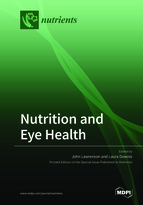Nutrition and Eye Health
A special issue of Nutrients (ISSN 2072-6643).
Deadline for manuscript submissions: closed (28 February 2019) | Viewed by 101302
Special Issue Editors
Special Issue Information
Dear Colleagues,
Blindness and visual impairment impact significantly on an individual’s physical and mental well-being. Loss of vision is a global health problem, with approximately 250 million of the world’s population currently living with vision loss, of which 36 million are classified as blind. Visual impairment is more frequent in the elderly, with cataract and age-related macular degeneration (AMD) accounting for over 50% of cases globally. Oxidative stress has been strongly implicated in the pathogenesis of both conditions, and consequently the role of nutritional factors, in particular carotenoids and micronutrient antioxidants, have been investigated as possible preventative or therapeutic strategies.
Dry eye syndrome (DES) is one of the most common ophthalmic conditions in the world. DES occurs where the eye does not produce enough tears and/or the tears evaporate too quicklyleading to discomfort and varying degrees of visual disturbance. There has recently been a great deal of interest in the potential for oral or topical supplementation with essential fatty acids (EFAs), specifically omega-3 and omega-6 fatty acids, as an adjunct to conventional treatments for DES.
The objective of this Special Issue on ‘Nutrition and Eye Health’ is to publish papers describing the role of nutrition in maintaining eye health and the use of nutritional interventions to prevent or treat ocular disease. A particular (but not exclusive) emphasis will be on papers (reviews and/or clinical or experimental studies) relating to cataract, AMD and DES.
Prof. John Lawrenson
Dr. Laura Downie
Guest Editors
Manuscript Submission Information
Manuscripts should be submitted online at www.mdpi.com by registering and logging in to this website. Once you are registered, click here to go to the submission form. Manuscripts can be submitted until the deadline. All submissions that pass pre-check are peer-reviewed. Accepted papers will be published continuously in the journal (as soon as accepted) and will be listed together on the special issue website. Research articles, review articles as well as short communications are invited. For planned papers, a title and short abstract (about 100 words) can be sent to the Editorial Office for announcement on this website.
Submitted manuscripts should not have been published previously, nor be under consideration for publication elsewhere (except conference proceedings papers). All manuscripts are thoroughly refereed through a single-blind peer-review process. A guide for authors and other relevant information for submission of manuscripts is available on the Instructions for Authors page. Nutrients is an international peer-reviewed open access semimonthly journal published by MDPI.
Please visit the Instructions for Authors page before submitting a manuscript. The Article Processing Charge (APC) for publication in this open access journal is 2900 CHF (Swiss Francs). Submitted papers should be well formatted and use good English. Authors may use MDPI's English editing service prior to publication or during author revisions.
Keywords
- Age-related macular degeneration
- Cataract
- Dry Eye
- Antioxidants
- Carotenoids
- Lutein
- Zeaxanthin
- Essential fatty acids
- Omega 3
- Omega 6







